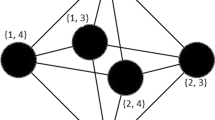Abstract
In general a contractible simplicial complex need not be collapsible. Moreover, there exist complexes which are collapsible but even so admit a collapsing sequence where one “gets stuck”, that is one can choose the collapses in such a way that one arrives at a nontrivial complex which admits no collapsing moves. Here we examine this phenomenon in the case of a simplex. In particular, we characterize all values of n and d so that the n-simplex may collapse to a d-complex from which no further collapses are possible. Equivalently, and in the language of high-dimensional generalizations of trees, we construct hypertrees that are anticollapsible, but not collapsible.
Similar content being viewed by others
References
K. A. Adiprasito, B. Benedetti and F. H. Lutz, Extremal examples of collapsible complexes and random discrete Morse theory, Discrete & Computational Geometry 57 (2017), 824–853.
B. Bagchi and B. Datta, Combinatorial triangulations of homology spheres, Discrete Mathermatics 305 (2005), 1–17.
B. Benedetti and F. H. Lutz, The dunce hat in a minimal non-extendably collapsible 3-ball, Electronic Geometry Models, Model no. 2013.10.001, http://www.eg-models.de/models/Polytopal_Complexes/2013.10.001.
B. Benedetti and F. H. Lutz, Random discrete Morse theory and a new library of triangulations, Experimental Mathematics 23 (2014), 66–94.
A. Björner and F. H. Lutz, Simplicial manifolds, bistellar flips and a 16-vertex triangulation of the Poincaré homology 3-sphere, Experimental Mathematics 9 (2000), 275–289.
A. Björner and M. Tancer, Combinatorial Alexander duality—a short and elementary proof, Discrete & Computational Geometry 42 (2009), 586–593.
M. K. Chari, On discrete Morse functions and combinatorial decompositions, Discrete Mathematics 217 (2000), 101–113
M. M. Cohen, A Course in Simple-Homotopy Theory, Graduate Texts in Mathematics, Vol. 10, Springer, New York-Berlin, 2012.
A. M. Duval, C. J. Klivans and J. L. Martin, Simplicial matrix-tree theorems, Transactiona of the American Mathematical Society 361 (2009), 6073–6114.
R. Forman, Morse theory for cell complexes, Advances in Mathematics 134 (1998), 90–145.
R. Forman, A user’s guide to discrete Morse theory, Sém. Séminaire Lotharingien de Combinatoire 48 (2002), Article no. B48c.
E. Gawrilow and M. Joswig, Polymake: a framework for analyzing convex polytopes, in Polytopes—Combinatorics and Computation (Oberwolfach, 1997), DMV Seminar, Vol. 29, Birkhäuser, Basel, 2000, pp. 43–73.
A. Hatcher, Algebraic Topology, Cambridge University Press, Cambridge, 2002.
M. Joswig, D. Lofano, F. H. Lutz, and M. Tsuruga, Frontiers of sphere recognition in practice, https://arxiv.org/abs/1405.3848.
M. Kahle, F. H. Lutz, A. Newman and K. Parsons, Cohen-Lenstra heuristics for torsion in homology of random complexes, Experimental Mathematics 29 (2020), 347–359.
J. Kahn, M. Saks and D. Sturtevant, A topological approach to evasiveness, Combinatorica 4 (1984), 297–306.
G. Kalai, Enumeration of Q-acyclic simplicial complexes, Israel Journal of Mathematics 45 (1983), 337–351.
D. Kozlov, Combinatorial Algebraic Topology, Algorithms and Computation in Mathematics, Vol. 21, Springer, Berlin, 2008.
N. Linial and Y. Peled, Enumeration and randomized constructions of hypertrees, Random Structures & Algorithms 55 (2019), 677–695.
U. Pachner, Konstruktionsmethoden und das kombinatorische Homöomorphieproblem für Triangulationen kompakter semilinearer Mannigfaltigkeiten, Abhandlungen aus dem Mathematischen Seminar der Universität Hamburg 57 (1987), 69–86.
U. Pachner, P.L. homeomorphic manifolds are equivalent by elementary shellings, European Journal of Combinatorics 12 (1991), 129–145.
M. Tancer, Recognition of collapsible complexes is NP-complete, Discrete & Computational Geometry 55 (2016), 21–38.
J. H. C. Whitehead, Simplicial Spaces, Nuclei and m-Groups, Proceedings of the London Mathematical Society 45 (1939), 243–327.
E. C. Zeeman, On the dunce hat, Topology 2 (1964), 341–358.
Acknowledgment
Both authors thank Frank H. Lutz for suggesting this problem and for several helpful comments on an earlier draft of the article.
Author information
Authors and Affiliations
Corresponding author
Additional information
The authors were supported by the Deutsche Forschungsgemeinschaft (DFG, German Research Foundation) Graduiertenkolleg “Facets of Complexity” (GRK 2434).
Rights and permissions
About this article
Cite this article
Lofano, D., Newman, A. The worst way to collapse a simplex. Isr. J. Math. 244, 625–647 (2021). https://doi.org/10.1007/s11856-021-2184-3
Received:
Revised:
Published:
Issue Date:
DOI: https://doi.org/10.1007/s11856-021-2184-3




